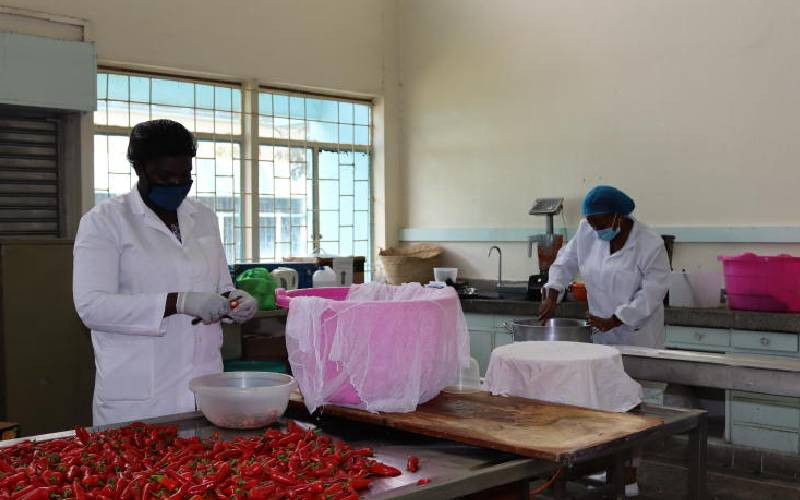Staff attrition at the Kenya Industrial Research and Development Institute (KIRDI) has been mentioned as one of the reasons behind shrinking innovation in the industrial space that is key for the growth of Micro, Small and Medium Enterprises (MSMEs).
KIRDI, in its latest strategic plan, says the departure of scientists and the reluctance of some to update on their innovation has affected the rate at which the research body churns out innovative products.
The institute is now seeking the help of regulatory bodies to aid in the commercialisation of the developed products. This is as it eyes Sh80 million in revenue, raised from intellectual property (IP) by 2027. This is according to its latest strategic plan.
The research body under the State Department of Micro, Small and Medium Enterprise Development also projects Sh275 million as the value of machinery, industrial equipment, tools and parts developed and commercialised.
These targets documented in KIRDI’s 2023-2027 strategic plan are against low rate commercialisation of research outputs, which it also blames on inadequate research infrastructure and reduced funding to produce commercialisable products.
KIRDI, which is one of the national research bodies, is the State agency mandated to research and develop industrial technologies and innovation and grow the country’s industries.
Promote linkages
It works closely with MSMEs, particularly in the jua kali sector. In the plan, KIRDI says it will position itself to support MSMEs to develop and upgrade their products, technologies and processes, in line with the Bottom-up Economic Transformation Agenda (BETA).
It also seeks to support and promote linkages between MSMEs and established national, regional and global production value chains, for the realisation of the African Continental Free Tarde Area (AfCFTA).
Over the years, KIRDI is said to have made 67 IP applications in the following areas: patents (47), industrial designs (five), utility models (10), and trademarks (10).
KIRDI has received 14 grants from these applications, which are distributed as follows: patents (five), utility models (four), trademarks (three) and industrial designs (two).
According to the strategic plan, in the last five years (2019-2023), KIRDI researchers undertook 120 research projects and developed 40 new products.
However, only six applications were filed.
“This represents approximately four per cent of IP applications, implying huge leakages of commercialisable research outputs,” KIRDI says in the plan.
The institution notes that some of the factors contributing to the low conversion rates include low level of reporting by researchers on the potential of their outputs for IP filing, inadequate human and financial resources to support IP management in KIRDI.
Stay informed. Subscribe to our newsletter
“During the period, the institute lost 15 highly qualified and experienced research scientists, a development which affected the implementation of several research programmes. In addition, the support departments continued to lose staff, which affected their ability to support the core mandate activities,” says the State firm.
Economic value
KIRDI says not all research outputs have found their way to the market or generated economic value for the Institute.
“The strategic plan will focus on improving research commercialisation in KIRDI thereby contributing to technological, economic and social growth of the country,” it says.
The Institute seeks the support of regulatory agencies among them the Kenya Bureau of Standards, Kenya Industrial Property Institute, Kenya Accreditation Services and the Anti-Counterfeit Authority in its quest to increase the rate of commercialisation.
“Develop and enforce standards for manufactured products trading in Kenya; certification for products; protect IP; provide accreditation services and combat counterfeit trade,” details KIRDI’s expectation of the regulatory bodies.
The State body notes that inadequate research equipment in various centres and use of obsolete equipment has hampered the quality and quantity of research outputs and its ability to effectively provide innovative solutions to industry.
Plant facilities
The institute however made efforts to upgrade laboratory and pilot plant facilities at KIRDI Western Region Centre (KWRC), Engineering and Information Communication and Technology Research Centre, Food Technology Research Centre, and Energy Resources and Energy Efficiency Research Centre.
“The newly re-established Environmental Sustainability and Climate Change Research Centre was not equipped and hence is still incapable of offering technical support to industry,” it notes.
“The leather and leather goods unit in KWRC was operationalised and is actively supporting numerous MSMEs in the western region of the country to add value to their hides and skins.”
KIRDI says inadequate research infrastructure has limited its ability to produce innovative products and technologies. This, it noted, has had a negative impact on the number of registered and commercialised IPs.
KIRDI said it has supported 4,532 MSMEs through technology incubation, common manufacturing facilities, training, consultancy and laboratory services.
“This intervention is estimated to have created an additional 16,800 jobs in the manufacturing sector. In addition, the Institute upgraded 97 MSMEs products to enhance their competitiveness,” says KIRDI.
“These products have acquired standardisation marks and can thus access local and international markets.”



















Discussion about this post